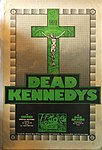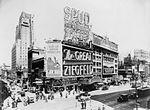Olympia Theatre (New York City)
1895 establishments in New York (state)Event venues established in 1895Former theatres in ManhattanLoew's Theatres buildings and structuresTheater District, Manhattan ... and 3 more
Theatres completed in 1895Times Square buildingsToys "R" Us

The Olympia Theatre (1514–16 Broadway at 44th Street), also known as Hammerstein's Olympia, was a theatre complex built by impresario Oscar Hammerstein I in Longacre Square (later Times Square), New York City, opening in 1895. It consisted of a theatre, a music hall, a concert hall, and a roof garden. Later, sections of the structure were substantially remodeled and used for both live theatre and for motion pictures. As a cinema, it was also known at various times as the Vitagraph Theatre and the Criterion Theatre.
Excerpt from the Wikipedia article Olympia Theatre (New York City) (License: CC BY-SA 3.0, Authors, Images).Olympia Theatre (New York City)
West 44th Street, New York Manhattan
Geographical coordinates (GPS) Address Nearby Places Show on map
Geographical coordinates (GPS)
| Latitude | Longitude |
|---|---|
| N 40.75738 ° | E -73.9857 ° |
Address
Times Square
West 44th Street
10036 New York, Manhattan
New York, United States
Open on Google Maps









